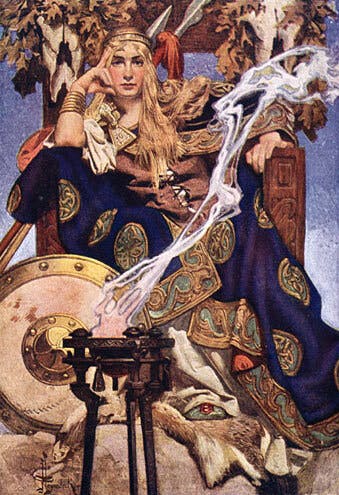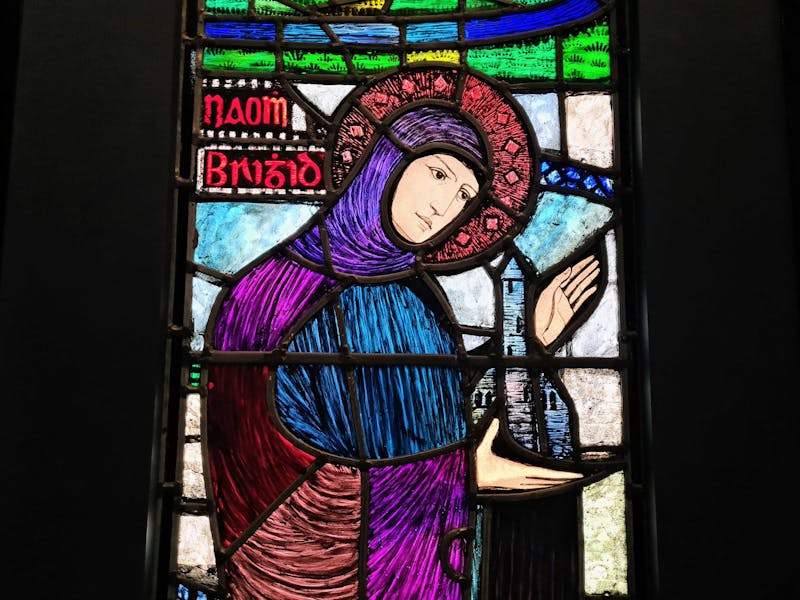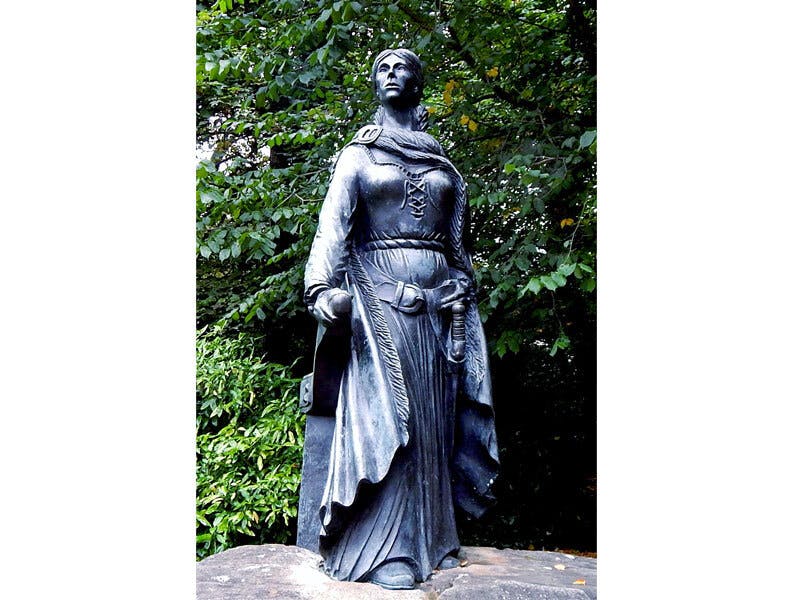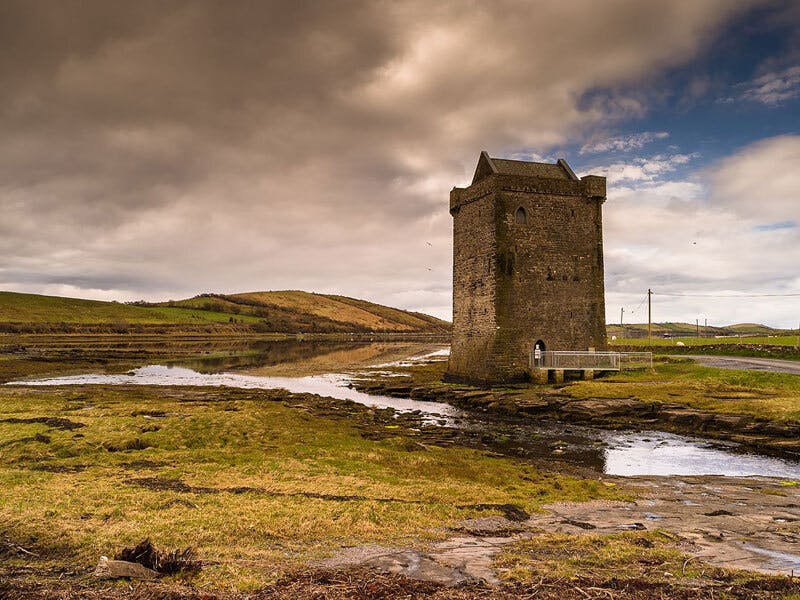

You are most welcome Martina. So glad you enjoyed it and thanks for your feedback.
Written by Jane Chadwick on Mar 07, 2022 | 2 Comments
In honor of International Women’s Day, we wanted to take a moment to celebrate spectacular Irish women, past and present. With ranks including a queen, a saint, a pirate, a revolutionary, a designer, an adventurer, and a president, these nine are an eclectic and fascinating bunch. Read on to find out more.
Queen Maeve, or Medb in old Irish, is known as a powerful ruler of ancient Ireland. Presiding over the province now known as Connacht for nearly 60 years, she is central to one of the most famous pieces of ancient Irish literature, the Táin Bó Cuilnge - the Cattle Raid of the Cooley.

Known as a “Warrior Queen,” Maeve succeeded her father as ruler of Connaught. Her marriage to Conchobar mac Nessa, the high king of Ulster, united two powerful kingdoms, but Maeve reportedly greatly disliked Conchobar. After bearing him a son she left, apparently making a ferocious enemy in the process. Deciding she had specific requirements of any future husband, she decreed that he should be without fear, meanness, or jealousy.
“‘For 'tis I that exacted a singular vow, such as no woman before me had ever required of a man of the men of Erin, namely, a husband without avarice, without jealousy, without fear. For should he be mean, the man with whom I should live, we were ill-matched together, inasmuch as I am great in largess and gift-giving, and it would be a disgrace for my husband if I should be better at spending than he, and for it to be said that I was superior in wealth and treasures to him, while no disgrace would it be were one as great as the other. Were my husband a coward, 'twere as unfit for us to be mated, for I by myself and alone break battles and fights and combats, and 'twould be a reproach for my husband should his wife be more full of life than himself, and no reproach our being equally bold. Should he be jealous, the husband with whom I should live, that too would not suit me, for there never was a time that I had one man in the shadow of another.”
An extract from Táin Bó Cuilnge
Her high standards might explain why she was reputed to have four further husbands during her life!

As with many Irish stories, the truth can be hard to untangle from the myth after all this time. Local legend holds that Maeve was buried standing upright, facing her mortal enemies in Ulster in a forty foot tall stone cairn at the summit of Knocknarea Mountain, County Sligo. It remains one of the largest intact megalithic monuments in Europe, so Maeve’s mystery will continue until the day it is excavated and studied!
If she existed, she would have lived, loved, ruled, and fought sometime between the years 50 BCE - 50 CE. Some suspect that Maeve may have been a Sovereignty goddess: the rite of kingship in Ancient Ireland included the king symbolically marrying the land. If this is Maeve’s origin, it explains her demands on her husband.
St Brigid of Kildare was reportedly born a slave in Dundalk around 451 AD. Her resumé includes becoming a nun, an abbess, and founding several monasteries, most notably in Kildare. Many stories surround this formidable woman.
An educator of hundreds of women in an age when women’s learning was seen as wasteful, she refused an arranged marriage - reportedly by plucking out her own eye! - to dedicate her life to charity and the church.
Perhaps the most famous tale of Brigid recounts her weaving a cross from rushes covering the floor at the bedside of a dying pagan chieftain. As St. Brigid explained the cross, her words soothed the dying man and he was moved to be baptized before passing away in peace.
St. Brigid is said to have peacefully passed away on February 1st, AD 523. Over the centuries, Irish people have celebrated their patron saint by making and displaying her cross to bless their home each year. Recognized as a patron saint of Ireland, from 2023 Brigid will be given the same respect as Patrick, with her own national holiday at the start of February.

With the family motto “Terra Marique Putens” - valiant by sea and land - the infamous O’Malley clan rose to power in Mayo in the 14th century. Unusually, the most famous of this infamous O’Malley clan was not a son but a daughter, Grainne or Grace.
Born around 1530, the only daughter of chief Eoghan “Black Oak” O’Malley, young Grace wanted nothing more than to join her father at sea. After being told the sea was no place for a girl and that her long hair would catch in the ropes, Grace promptly shaved her head and boarded her father’s ship as Grainne Mhaol, Bald Grace!
Quickly proving both courage and competence, she rose to become a captain as well as a canny sea trader and ruthless corsair. With her father’s death she inherited his empire, becoming queen of Umaill, the chieftain of the Ó Máille clan.

Married and widowed by the age of twenty-three, Grainne had three children, a fleet of fighting ships, and Bunowen Castle under her remit. She remarried judiciously, thereby adding Rockfleet Castle to her riches, and reportedly divorced her husband after a year!

There are many stories that surround this legendary commander. She reportedly gave birth to her son Tiobóid in the midst of a sea battle and was back rallying her crew, babe in arms within the hour. As a pirate, and a female, O'Malley was largely written out of Irish history so the details of her life and death are hazy. However, modern historians think Grace died of natural causes at Rockfleet Castle in 1603. It is believed she was buried on Clare Island at the abbey where she was taught to read and write as a child.
Born on St. Patrick's Day in 1785, Ellen Hutchinson was a botanist specializing in collecting and identifying plants growing in and around the West Cork coastline. Plagued with ill health in her younger years, a family friend recommended botany as a healthy hobby appropriate for a young lady of her time. She combined the search for specimens with detailed watercolour images much admired by the leading botanists in the UK and Ireland.
Renowned for discovering numerous new species, and for her voluminous correspondence with others in her field, her work is housed in many of the most important museum collections worldwide. She has no fewer than eight species named after her, and a festival in her honor has taken place in Bantry, County Cork, since 2015.

Born in County Wexford in 1878, Eileen Grey's clean, minimalist style of design and architecture is instantly recognisable today. As an architect, she completed her first project at the age of fifty-one, having worked as an interior designer, learned the Japanese skill of lacquered screens, and ran her own interiors boutique in Paris.
Now routinely hailed as a pioneer of Modernism, she was largely overlooked until art historian Joseph Rykwert, writing in Architectural Review in 1972, praised her "inventiveness" and "visionary intuition." Although she spent much of her life in France and is buried in the Pere Lachaise cemetery in Paris, she is reported to have said, "I am without roots, but if I have any, they are in Ireland."

Born in 1860 in Dublin, and raised in Co. Wicklow, Elizabeth refused to believe that mountaineering and photography were the preserve of men when fashion and etiquette demanded more sedate behavior of women.
Born into a wealthy family, she moved to Switzerland at twenty-one and published her first book at twenty-two. Despite suffering lung problems, she persisted in expeditions to Lapland and spent six summers in the Norwegian Arctic, where it is recorded that she completed twenty-seven first ascents, all while carrying her trusty camera. She wrote about her experiences while mountaineering and traveling and, in 1907, founded and became President of the Ladies Alpine Club to help other women follow in her footsteps.
For many, the revolutionary Constance Markievicz might be one of the first names to spring to mind when asked to name a ‘famous Irish woman.’ Born in 1868, she was the daughter of a famous Arctic explorer and befriended the iconic Irish poet W.B Yeats as a child.
As a student in London she discovered an interest in politics and women’s suffrage, and on her return to Dublin enlisted in a number of nationalist movements looking to secure Irish independence. During the 1916 Rising she helped command a group that held off opposition for six days despite huge disadvantages in arms and personnel. She was eventually captured, imprisoned, and sentenced to a lifetime in prison. Her time in jail was short, however, and she was released under an amnesty agreement a year later. On the 28th of December 1918, she became the first ever woman elected to the British House of Commons.
In a powerfully symbolic act, she refused to take her seat and instead chose to govern from the newly founded Dáil Eireann in Dublin, becoming Minister for Labour (1919 - 1922.) She fought and was again imprisoned during the Irish Civil War, and was again elected to the newly official Irish government. She had proved her mettle as a revolutionary however she never got to govern in the free Ireland she had fought for, dying from appendicitis before she could take up her seat. The famous playwright Seán O'Casey remembered her well saying: "One thing she had in abundance—physical courage; with that she was clothed as with a garment.” The first - and indeed the only until 1979 - female cabinet minister in Ireland, and the second in Europe, her legacy for women in politics is immense.
Born in 1874, Annie Moore was eighteen years old when she traveled with her two brothers from Cobh in County Cork to New York. Upon disembarking from the steamship Nevada, she became the first person to pass inspection at the newly opened federal immigrant inspection station at Ellis Island. The three siblings joined their parents in the Lower East Side of Manhattan that was to become their home. Annie married and raised her family in the same area; when she died, she was buried in Queens, NY. She might be pleased to hear that a software program using algorithms to match refugees to the most suitable area for their relocation has been named Annie in her honor."

Everyone in Ireland and many farther afield know this modern day Irish heroine. The first female President of Ireland, she remains our most popular president ever, at one point having an approval rating of 93%!
Born Mary Bourke in Co. Mayo in 1944, she grew up to pursue a career in the law, becoming a well respected academic, barrister, and Senator long before being elected President of Ireland in 1990. As an independent politician, she fought for women's rights including the right to the legal availability of contraception, a removal of the requirement that married women resign from the civil service, and the right for women to sit on juries.
As president she got things done and is widely respected for revitalising the role and passing two important bills into law: legalisation of contraception and decriminalising homosexuality. Even Brian Lenihan, her beaten opponent in the presidential race, said she was a better President than he ever could have been! However her tenure as President was short lived, resigning toward the end of her first term to take up a position as the UN High Commissioner for Human Rights. She remained a UN Commissioner until 2002, and continues to work with the world’s top leaders on various human rights issues.

We hope that we have motivated you to celebrate the audacious and cherished Irish women in your life. We hear incredible things from our customers about the astonishing resilience, creativity, and love of the women in their lives - we are always deeply honored when you share your stories with us.
If you are a regular reader of our newsletter, our blog, or follow us on social media, you will know that we would flounder without the magnificent women of MIJ: their dedication to making sure each and every customer has an exceptional experience is the backbone of our business.
Have a question or something you're not entirely sure about when browsing our pieces? Please reach out. You can send us a note or give us a call—the Dublin workshop is here to make sure that you have a perfect experience from start to finish with My Irish Jeweler.
Follow us on Facebook and Instagram, to see what's new and upcoming. Join our Email list for early offers and special features.

Jane Chadwick
My Irish Jeweler
Born in Dublin but reared in Canada, as a child I had an interest in Ireland that will be familiar to many young emigrants. I was completely fascinated, wanting to know all about the land of my parents and grandparents. Rare month-long family trips back "Home" cemented my love for Ireland. And I wore my Irish heritage with pride, sporting my tiny silver Claddagh gifted to me by my Irish grandparents until my finger grew too large for it!
As a young adult I moved back to Dublin, studying Geology and Mineralogy in university at historic Trinity College Dublin. After living in Denmark and the Netherlands working as a scientist and university mineralogy lecturer, I finally settled back home in Dublin. I joined the growing family at My Irish Jeweler in 2016, bringing my useful knowledge of metals and minerals as well as my perspective as an Irish emigrant with a love for HOME.


You are most welcome Martina. So glad you enjoyed it and thanks for your feedback.

Fabulous article.
Thank you.